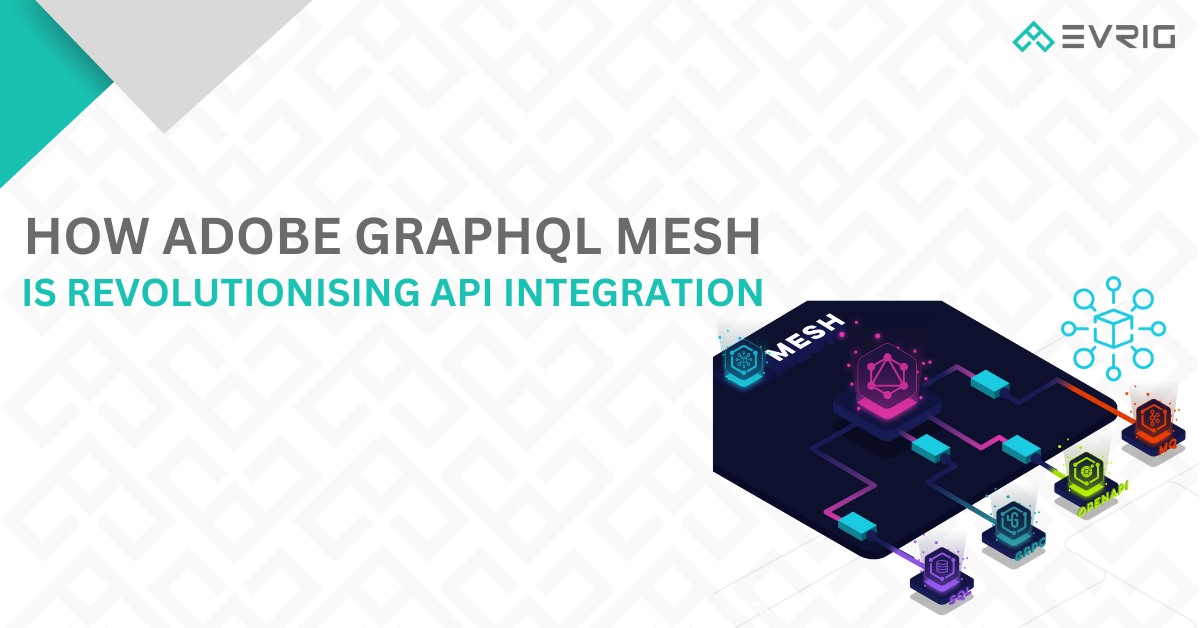How Adobe GraphQL Mesh is Revolutionising API Integration
- May 29, 2023
- Categories: Magento, Magento 2

What does Adobe GraphQL Mesh entail?
Adobe GraphQL Mesh functions as an API gateway, allowing front-end applications to interact with multiple underlying systems through a unified interface. By consolidating data into a comprehensive data schema, the mesh enables data transformation and manipulation based on predefined rules.
When a request is made to the mesh, it is simultaneously analysed and forwarded to the respective underlying systems. This parallel processing ensures that the response time is determined by the slowest request, resulting in enhanced performance across the board.
Integration and Conflict Resolution in Adobe GraphQL Mesh
To ensure smooth integration within Adobe GraphQL Mesh, interfaces need to have formal descriptions of their data structures. This can be achieved by utilising existing GraphQL schemas or JSON schemas for REST APIs. Adobe Commerce (Magento) effortlessly facilitates seamless integration without any complications.
Nevertheless, conflicts may arise when multiple interfaces define identical entities, like “Product”. However, Adobe GraphQL Mesh offers solutions to address such scenarios by enabling entity renaming or prefixing. These modifications are only visible to direct users of Adobe GraphQL Mesh, while the underlying interfaces retain their original names.
Scenarios for Applying Adobe GraphQL Mesh
One possible scenario for utilising Adobe GraphQL Mesh is integrating multiple systems, such as a headless CMS like Storyblok, Adobe Commerce (Magento) as the e-commerce platform, and an ERP system that provides real-time user-specific pricing, into a single front-end application. By acting as a centralised gateway, GraphQL Mesh efficiently distributes requests to the appropriate systems and consolidates their responses. This streamlined approach enables developers to manage data flow effectively and maintain data consistency across diverse systems.
Another scenario involves integrating a set of microservices into a larger application. In a microservices architecture, applications are composed of smaller services that perform specific business functions and communicate through APIs. Integrating these services, each with its unique data model, can be complex. Adobe GraphQL Mesh serves as a central access point, facilitating seamless communication and simplifying integration among the microservices.
Advancing Towards Composable Commerce
Advancing towards a composable commerce approach has increased the demand for solutions like Adobe GraphQL Mesh. Composable Commerce allows businesses to construct their commerce platforms using modular components sourced from leading vendors. Adobe GraphQL Mesh acts as the seamless connection between these diverse modules, facilitating smooth data flow.
Furthermore, GraphQL Mesh proves advantageous in scenarios involving legacy system integration. Legacy systems often present challenges due to outdated or proprietary APIs. However, GraphQL Mesh functions as a translation layer, enabling communication between applications and legacy systems. It converts requests into a format understandable by the legacy system and transforms responses into a format the application comprehends.
These instances exemplify the flexibility and power of Adobe GraphQL Mesh in various application scenarios. Regardless of the specific architecture or systems involved, GraphQL Mesh provides an efficient and reliable solution for integrating and coordinating systems and services.
Configuring and Operating
Configuring and operating Adobe GraphQL Mesh involves utilising a centralised YAML file. This file specifies the data sources and rules that govern request forwarding and response processing within the mesh. Additionally, the YAML configuration file facilitates the integration of Adobe Commerce SaaS services, such as Live Search or Catalog Services, as data sources, enhancing the mesh’s data flow and capabilities.
Adobe App Builder complements the mesh by offering a platform for building custom extensions. Developers can create specialised features or customizations directly through the App Builder, which are then accessible via the GraphQL Mesh. This functionality expands the mesh’s flexibility, enabling tailored solutions to address specific requirements.
Adobe GraphQL Mesh empowers modern businesses to optimise system integration, streamline data access, and facilitate data transformation. With its seamless connection of disparate systems and efficient conflict resolution, Adobe GraphQL Mesh establishes new standards for API utilisation.
Conclusion
Evrig Solutions is at the forefront of leveraging the transformative power of Adobe Commerce Cloud development services. With its expertise in integrating Adobe GraphQL Mesh and other cutting-edge technologies, Evrig Solutions revolutionises API integration for businesses. By harnessing the capabilities of Adobe Commerce Cloud, Evrig Solutions empowers clients to enhance their e-commerce platforms with seamless data integration, streamlined operations, and exceptional customer experiences. With Evrig Solutions as your trusted partner, you can unlock the full potential of Adobe Commerce Cloud and drive your business towards unprecedented success in the ever-evolving digital landscape.
